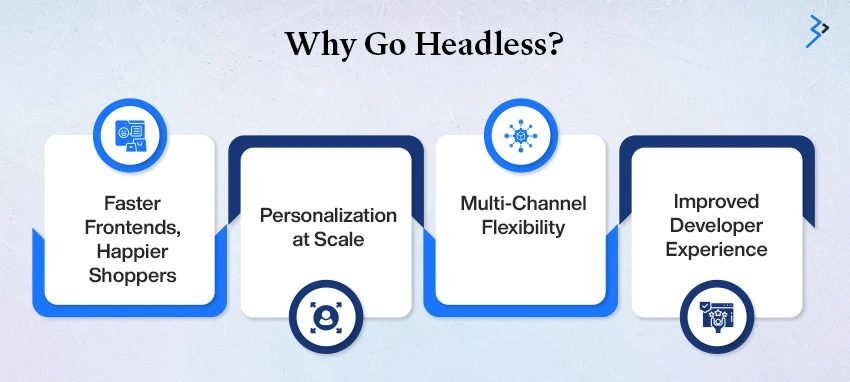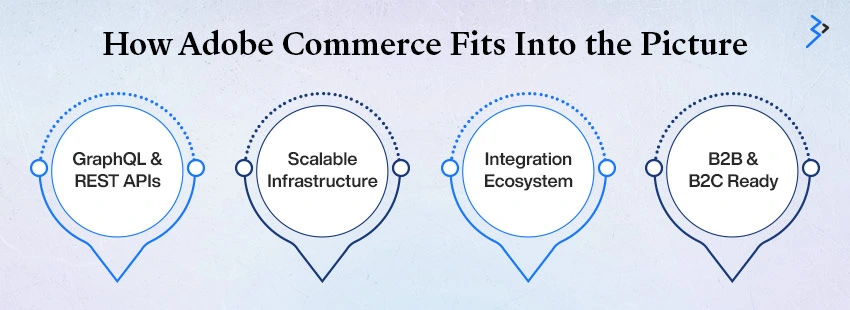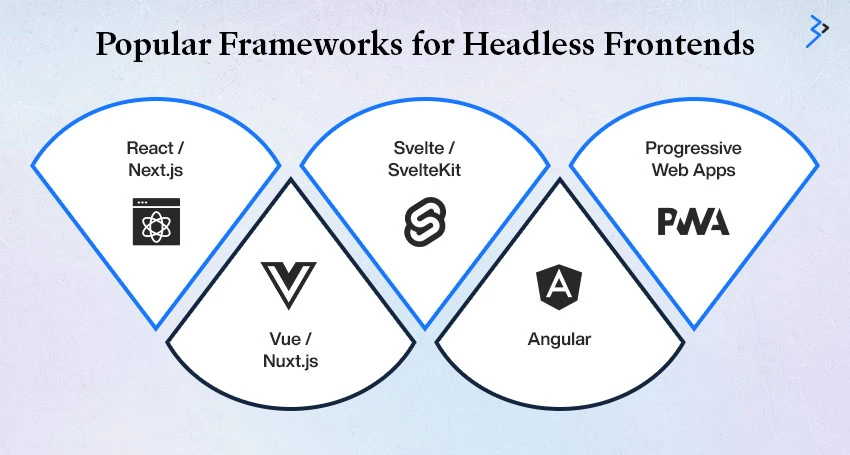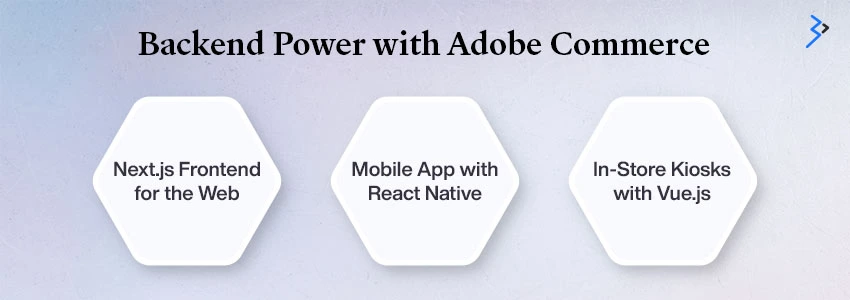Table of contents
What Is Headless Commerce, Really?
Why Go Headless?
How Adobe Commerce Fits Into the Picture
Popular Frameworks for Headless Frontends
Building Blocks of a Headless Storefront
Real-Life Use Case: Going Headless with Adobe Commerce
Measuring the ROI of Headless Commerce
Challenges and Considerations
Future of Headless Commerce
Key Takeaways
Final Thoughts: Embracing Headless for Digital Growth
FAQs
Let’s start with a quick thought experiment. Imagine walking into your favorite retail store. Now imagine that the store rearranges itself every time you visit — based on your habits, preferences, the time of day, and even the weather. Sounds futuristic? That’s exactly what headless commerce brings to the digital shopping experience.
We’re living in an age where eCommerce is no longer about just selling products online. It’s about delivering personalized, consistent, and fast experiences across every channel your customer touches. And that’s where Headless Commerce Accelerated strategies enter the spotlight.
In this post, we’ll explore how brands are leveraging Adobe Commerce development services with modern frontend frameworks to build future-ready, scalable storefronts. From better performance to richer UX, let’s dive into why headless is the new default and how you can make the most of it.
What Is Headless Commerce, Really?
Let’s get the definitions out of the way — but we’ll keep it simple.
Headless commerce is an architecture where the frontend (the "head") is separated from the backend (where product, cart, and order management live). This gives brands the flexibility to build unique digital experiences using their favorite frontend technologies — think React, Vue, Angular — without being tied to the limitations of traditional monolithic platforms.
So instead of a tightly coupled system, you get two independent layers that talk to each other via APIs. This approach unlocks performance, speed, design freedom, and omnichannel scalability.
Why Go Headless?
In an era where customer expectations evolve faster than technology itself, traditional eCommerce platforms are struggling to keep up. That’s where headless commerce shines. Businesses unlock new levels of flexibility, performance, and innovation by decoupling the frontend from the backend. If you're still on the fence, here’s a deeper look at the key advantages that make going headless a smart, future-focused move.
1. Faster Frontends, Happier Shoppers
Speed isn’t just a convenience—it’s a conversion factor. Slow-loading pages lead to bounce, while fast experiences drive engagement and sales. With headless commerce:
- Frontend frameworks like Next.js and Nuxt.js support server-side rendering (SSR), static site generation (SSG), and image optimization to improve load times.
- APIs allow selective data fetching, so your frontend only loads what it needs.
- Mobile-first optimization becomes easier, helping boost speed and UX on smartphones and tablets.
Faster websites translate into better SEO rankings, lower bounce rates, and ultimately, higher conversion rates.
2. Personalization at Scale
One-size-fits-all experiences don’t cut it anymore. Today’s customers expect content tailored to their behavior, preferences, and context. Headless commerce makes this possible through modular and dynamic architecture.
- APIs allow for real-time data exchange between the frontend and marketing tools or CRM solutions.
- Geo-targeting and seasonal personalization can be layered onto product recommendations and promotions.
- Segmentation and testing tools can be integrated easily for A/B testing and behavioral targeting.
This results in truly customized digital experiences that boost customer satisfaction and loyalty.
Read more - Scaling Your eCommerce Business Effectively with Adobe Commerce on AACS
3. Multi-Channel Flexibility
Today’s consumers interact with brands across multiple touchpoints—from desktops and smartphones to smartwatches, kiosks, and even voice assistants. With headless commerce, you only need one backend to support all of them.
- Single source of truth for inventory, pricing, and content ensures consistency.
- Build specific frontend layers tailored to each platform—web, mobile app development, IoT, or POS.
- Easier integrations with third-party platforms like TikTok, Instagram, Amazon, and more.
This omnichannel readiness not only increases your brand's reach but also delivers a seamless, cohesive customer experience.
4. Improved Developer Experience
Let’s not forget the people building and maintaining your platform. Developers benefit greatly from the headless approach because it empowers them to work faster, smarter, and with greater control.
- Freedom to choose tech stacks that best fit the project requirements.
- Reusable components improve development efficiency and consistency across experiences.
- Independent deployments mean frontend and backend updates can happen without disrupting each other.
This agility leads to shorter development cycles, quicker iterations, and a more adaptable platform overall.
Going headless is about more than just following a trend—it’s about preparing your business for what’s next. From lightning-fast frontends to omnichannel adaptability and happier development teams, the benefits are both immediate and long-term. If your goal is to create experiences that stand out, scale effortlessly, and keep customers coming back, headless commerce is the way forward.
How Adobe Commerce Fits Into the Picture
Adobe Commerce (formerly Magento) is a powerful backend platform that provides robust features like product management, pricing rules, promotions, customer segmentation, and more. When used in a headless architecture, it becomes the brain behind your commerce operations.
Here’s why Adobe Commerce works so well with modern frontend frameworks:
- GraphQL & REST APIs: Adobe Commerce supports both out of the box. That means frontend apps can easily fetch exactly the data they need, nothing more.
- Scalable Infrastructure: Built to support enterprise-level stores, Adobe Commerce is cloud-native and highly scalable, perfect for growing brands.
- Integration Ecosystem: With support for third-party integrations, Adobe Commerce connects seamlessly to CRMs, ERPs, PIMs, and CDPs.
- B2B & B2C Ready: Whether you’re serving individuals or businesses, Adobe Commerce has the features to support complex catalogs, account hierarchies, and workflows.
When you combine Adobe Commerce with a modern JavaScript frontend like React or Vue, you get the best of both worlds: an enterprise-grade backend with pixel-perfect, blazingly fast user experiences.
Popular Frameworks for Headless Frontends
Choosing the right frontend framework is key to delivering a fast, scalable, and engaging digital experience. With headless commerce, developers have the freedom to select technologies that match their team’s skills and business goals. Below are some of the most popular frameworks powering headless storefronts today:
1. React / Next.js
- Why it’s popular: React has become the industry standard for building dynamic user interfaces. Developed by Meta, it’s known for its component-based structure, making code easier to manage and reuse.
- Why Next.js matters: Next.js builds on React’s strengths by adding powerful features like server-side rendering (SSR), static site generation (SSG), and automatic code splitting. These enhancements improve SEO, reduce load times, and deliver smoother browsing experiences.
- Use case: Ideal for brands focused on performance, SEO, and rapid development.
2. Vue / Nuxt.js
- Why it’s popular: Vue is loved for its simplicity, flexibility, and gentle learning curve. It’s ideal for teams that want to build interactive UIs without the complexity of larger frameworks.
- Why Nuxt.js matters: Nuxt turns Vue into a full-fledged framework, offering SSR, routing, and modular architecture out of the box. It’s a go-to for SEO-focused, lightweight, and scalable eCommerce projects.
- Use case: Perfect for smaller teams or startups that value agility and maintainability.
3. Svelte / SvelteKit
- Why it’s popular: Svelte stands out by compiling code at build time, resulting in ultra-fast runtime performance. It avoids the virtual DOM altogether, making apps lighter and more efficient.
- Why SvelteKit matters: SvelteKit brings routing, SSR, and endpoint handling to Svelte, making it viable for full-scale headless builds.
- Use case: Great for teams prioritizing performance and modern development trends.
4. Angular
- Why it’s popular: Angular is a full-fledged enterprise framework backed by Google. It includes everything from routing to state management and testing tools.
- Scalability matters: Though heavier than React or Vue, Angular’s structure is beneficial for large-scale, mission-critical applications where team collaboration and architecture consistency are key.
- Use case: Ideal for enterprise projects with strict technical requirements and larger development teams.
5. Progressive Web Apps (PWAs)
- Why it’s popular: PWAs combine the best of web and mobile apps — fast loading, offline functionality, and push notifications.
- Why it’s essential: Adobe’s PWA Studio is designed specifically for building headless storefronts with Adobe Commerce, helping brands create immersive, app-like experiences in the browser.
- Use case: Best for businesses wanting a native app feel without building a separate mobile application.
Building Blocks of a Headless Storefront
Building a headless storefront isn’t just about picking a fancy frontend framework. Here’s what you’ll need under the hood:
| Component | Purpose |
| Frontend Framework | React, Vue, Angular for rendering UI |
| API Layer | REST or GraphQL to communicate with Adobe Commerce |
| CMS Integration | For managing content (e.g., Adobe Experience Manager, Contentful) |
| Search Engine | Elasticsearch or Algolia for real-time search capabilities |
| CDN & Hosting | Platforms like Vercel, Netlify, or AWS for blazing-fast delivery |
| DevOps Pipeline | Automated deployments, testing, and rollback strategies |
| Analytics | Track and optimize user behavior with tools like GA4, Adobe Analytics |
Real-Life Use Case: Going Headless with Adobe Commerce
Let’s take the example of a growing fashion retail brand with both online and physical store presence. Their goals are ambitious and modern:
- Launch a mobile-optimized website
- Integrate seamlessly with TikTok Shop and Instagram
- Deliver personalized experiences based on user location and seasons
- Offer BOPIS (Buy Online, Pick Up In-Store) functionality
To meet these objectives, they adopt a headless commerce strategy built around Adobe Commerce and modern frontend frameworks.
Read More - Meet Adobe Commerce Optimizer: The Key to High-Performance eCommerce
Backend Power with Adobe Commerce
Adobe Commerce manages the core business logic — product catalogs, inventory, promotions, pricing rules, and order fulfillment. Its robust API layer ensures consistent data delivery across all touchpoints.
Next.js Frontend for the Web
A custom-built storefront using Next.js handles the main user interface. It delivers lightning-fast load times and integrates real-time personalization using geo-location and seasonal data.
Mobile App with React Native
The mobile app, built in React Native, connects to the same Adobe Commerce backend via APIs, ensuring synchronized data and functionality.
In-Store Kiosks with Vue.js
To enhance the in-store experience, Vue-powered kiosks offer self-service features and product lookups, all connected to the central backend.
Content Management with Contentful
The brand’s marketing site and content blocks are managed in Contentful and integrated into the frontend using GraphQL, allowing marketers to update content effortlessly.
The Result
A seamless omnichannel experience, faster performance, and a flexible architecture that supports personalization and innovation — all driven by a future-ready headless setup.
Measuring the ROI of Headless Commerce
Transitioning to headless commerce may seem like a significant upfront investment, but the long-term returns make it a strategic move for growth-focused brands. By decoupling the frontend from the backend, businesses gain the agility to innovate faster and deliver superior customer experiences.
Here’s what brands typically experience after adopting a headless approach:
- 30-50% faster page load times
- 25% uplift in conversions
- Improved SEO performance
- Lower bounce rates
- Higher customer engagement across channels
These performance gains translate into better user satisfaction, increased sales, and greater brand loyalty. Headless isn’t a trend — it’s a future-proof framework for digital success.
Challenges and Considerations
While headless commerce offers impressive flexibility and performance, it's important to understand the challenges before making the leap.
- Initial Development Time is one of the biggest considerations. Unlike traditional setups with pre-built themes, headless architectures require building the frontend from scratch, which can extend project timelines.
- Ongoing Maintenance is another factor. You’ll need skilled frontend and backend developers to maintain, update, and troubleshoot separate systems. This often leads to increased dependency on a cross-functional team.
- Content Management can become complex if not well planned. Without a tightly integrated CMS, marketers may find it difficult to manage and update content across multiple frontends without technical help.
- Cost is a key concern. The initial investment in design, development, infrastructure, and integrations is higher compared to traditional platforms. However, this is often balanced out by better performance, customer experience, and long-term ROI.
Despite these hurdles, the value of a headless setup — especially for brands looking to scale, personalize, and innovate — makes it a future-ready investment. For those committed to delivering omnichannel excellence and seamless digital experiences, the rewards are well worth the effort.
Future of Headless Commerce
Looking ahead, headless will only grow more intelligent and modular. Expect innovations like:
- Composable commerce with interchangeable services (payments, search, checkout, etc.)
- AI-driven personalization is natively built into the frontend logic
- Voice and AR integration for immersive shopping
- Backendless frontends — think Jamstack + serverless + microservices
And as AI begins to assist in UI building and behavior prediction, the possibilities of what you can do with a headless setup will expand exponentially.
Key Takeaways
- Headless commerce separates the frontend from the backend, enabling greater design and development flexibility.
- Adobe Commerce offers a robust, scalable backend ideal for headless implementations.
- Frameworks like Next.js and Nuxt.js drive fast, responsive, and dynamic storefronts.
- Headless architecture enhances site performance, user experience, and omnichannel capabilities.
- While it demands upfront investment, headless commerce ensures long-term ROI, agility, and future-proof scalability.
Final Thoughts: Embracing Headless for Digital Growth
In this digital landscape, success hinges on your ability to adapt quickly, engage customers meaningfully, and deliver consistently across every touchpoint. Headless commerce — especially when combined with the power of Adobe Commerce and modern frameworks — offers the flexibility and performance needed to stay ahead.
This approach isn’t just a passing trend; it’s a forward-thinking strategy that equips your business for long-term growth. By decoupling the frontend and backend, you gain the freedom to innovate, personalize, and scale across channels without being held back by legacy systems.
If your vision includes faster time-to-market, global scalability, and seamless user experiences, going headless isn’t just a good idea — it’s a business imperative. The shift is already underway. The only question now is: Are you ready to lead it?
FAQs
1) What is the difference between traditional and headless commerce?
Traditional commerce tightly couples the frontend and backend, limiting flexibility. Headless commerce separates them, allowing independent development and faster, personalized user experiences.
2) Is Adobe Commerce suitable for headless architecture?
Absolutely. Adobe Commerce provides robust APIs, scalability, and powerful backend features, making it ideal for headless builds.
3) Do I need a separate CMS for content with headless commerce?
Not necessarily, but most brands use a CMS like Contentful or Adobe Experience Manager to manage content easily and integrate it via APIs.
4) How does headless commerce impact SEO?
With proper server-side rendering (SSR) using frameworks like Next.js, headless sites can outperform traditional ones in SEO. Faster load times and better user experience also boost rankings.
5) What kind of businesses benefit most from headless commerce?
Mid to enterprise-level businesses looking for customization, omnichannel selling, and rapid scaling will benefit most. It’s especially useful in fashion, electronics, B2B, and DTC brands.
Related Articles
Digital Transformation
Navigating the Future of Digital Commerce: Trends, Technologies, and Adobe’s Role
Success Stories
American Tire Depot Leverages Odoo-Adobe for Automotive Omnichannel eCommerce
Success Stories
Re-Defining Air Filtration globally with Odoo







